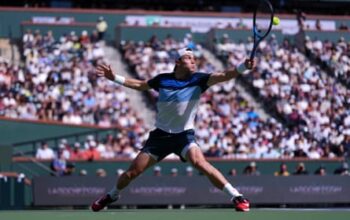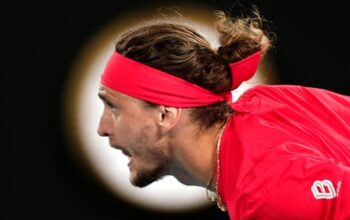
Three sinewy octogenarians and one unfeasibly hale-looking nonagenarian are the focus of this perky documentary looking at tennis players still holding their own in a late tiebreak with father time. A mixture of ex-pros and dogged late starters who picked the game up in middle age, they all converge at the International Tennis Federation senior world championships in Croatia; a tournament with more matches than Wimbledon. As serial winner King van Nostrand – a former maths teacher who was 85 at the time of filming – points out, small margins of age count; at a given point, a younger player of inferior ability will statistically start beating their older betters.
A stooping Floridian with a rapier grin, Van Nostrand has dominated the seniors circuit winning a record-breaking 43 titles and is still not tired of winning. His doubles partner is 87-year-old John Powless, a varsity-league and pro player whose beautiful stroke and attaboy magnanimity are intact, but whose energy is being sapped by chemo. Refusing to acknowledge her age (82), Etty Marouani is a coquettish former Parisian model who took up tennis at 42. Her girlish hair ribbon belies a killer determination to add the world title to her French seniors one. Most remarkable is 95-year-old Ukrainian Leonid Stanislavskyi, an amateur who picked up a racket to keep body and mind ticking over. He’s generally resigned to being battered by his juniors, with only two other nonagenarian competitors available. “Even if I lose, I’ll come third,” he says.
It’s nothing short of miraculous watching them scampering around court, with an unquenchable will to victory for many of them. While the aptly named Dan Lobb’s film sometimes dips into never-give-up platitudes, especially when padding out match sequences, it supplies plenty of the life-lessons. Positivity is clearly what has allowed most of these stalwarts to keep on trucking in the face of adversity: not just Powless’s cancer (he died in 2021), but also the premature loss of children and grandchildren in Van Nostrand’s case, and for Stanislavskyi being the last man standing in his social circle.
The podium-raiders of the bunch are obviously impressive, but it’s Stanislavskyi who sticks in the mind most. Perennially losing his matches, subsisting on the social interaction at these tournaments, perambulating with his racket poking out of his rucksack, he is both a lonely figure and powerfully symbolic. In other words, a true sportsman.



